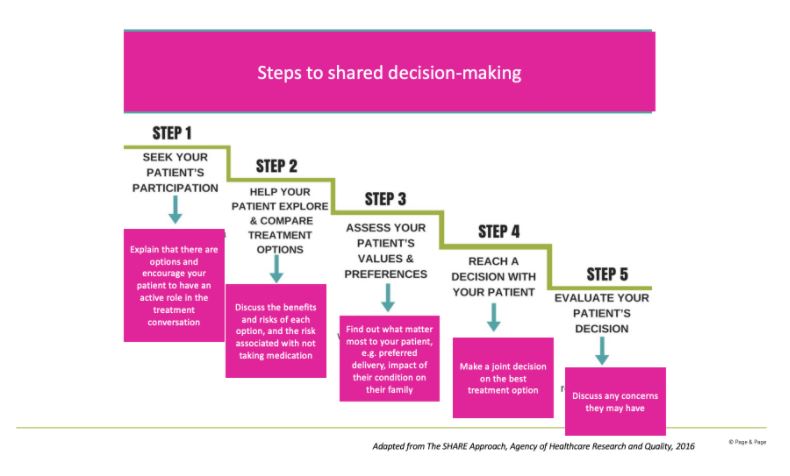The concordance conundrum: creating space for open dialogue
September 30, 2020 | HCP, concordance, open dialogue, patient concordance
Growing numbers of patients want a partnership model with their HCP, whereby both parties are equally involved in the decision-making process. This model has been linked with an increase in treatment concordance. However, achieving this delicate equilibrium does require the pharma industry to support HCPs to do their job more effectively when interacting with patients. So how can industry help?
Patients are almost unrecognisable today compared to 10 or 20 years ago when healthcare professionals (HCPs) often viewed patients as compliant, obedient and uninformed. Today’s patient is informed and has an opinion on what their potential diagnosis might be, and which tests and treatment options are available.
There is still and always will be a degree of inequity in the relationship because no matter how well-informed patients believe they are, they didn’t study for seven plus years and their source of information may not be trustworthy. Nonetheless, the dynamic between the parties has shifted and HCPs, with support from industry, need to be better equipped to answer probing questions about their choice of treatment and its likely side effects.
Arguably, in eagerly moving away from the paternalistic model of old, the pendulum has swung too far (there will be advocates and naysayers for both) in favour of an information-led relationship. The shared decision-making agenda aims at integrating these extremes in an atmosphere of respect (from both parties), cooperation and trust – a cooperative-deliberative model.
With the ‘excellence-of-the-product-is-all-that-matters’ era a thing of the past, the focus now is on experience and building trust across the industry-HCP-patient relationship continuum.
By opening up and rebalancing the discussion around medication, the consultation is likely to be more satisfying for all parties and, therefore, more effective with the patient having a true understanding of the importance of treatment concordance and the implications of non-concordance. This is not a guarantee that they will concord, but it is a step in the right direction.
Sounds obvious? It may well be but given that models to improve the HCP-patient dynamic date back to 1989, and we are still talking about it now, it seems there is still plenty of room for improvement.
In 2016, the Agency of Healthcare Research and Quality developed the SHARE Approach1 – a five-step process to open up dialogue between HCPs and patients.

Alongside this, it is important to gain an understanding of how this process can aid concordance.There are five pre-requisites for concordance in consultations:2
- A willingness to share power and a commitment to giving appropriate weight to patient values and goals
- Open discussion of the option, specifically to gain understanding of the patient’s views without making assumptions
- Adequate sharing of information including the uncertainties taken into consideration in arriving at the current decision
- Listening as much, if not more so, than talking
- Time – with a short amount of time available it is important that the patient does not feel hurried.
Barriers to a cooperative-deliberative model
For some this will still seem aspirational and difficult to achieve. There is a natural imbalance in the relationship in relative terms based on knowledge, which can elicit a raft of emotions from ‘hero’ complex at one end and inferiority at the other (underpinned by arrogance and confirmation basis; fear and uncertainty, respectively).
Not all patients are ready for shared decision-making – some still prefer a clinician-led approach but increasing numbers want partnership.
There is a middle ground, but it requires greater imagination and empathy, open-mindedness and the ability to listen actively; a true understanding that the quality of the communication is the responsibility of the communicator and not the recipient.
The role of industry
A move to this model is also reliant on changing the dynamic between the pharma industry and HCPs. A plethora of information exists for HCPs, but it is built around what the industry wants to say about its products and less around supporting HCPs to do their job more effectively in terms of increasing concordance.
A move to this model is also reliant on changing the dynamic between the pharma industry and HCPs. A plethora of information exists for HCPs, but it is built around what the industry wants to say about its products and less around supporting HCPs to do their job more effectively in terms of increasing concordance.
If shared decision-making is to succeed as a means of increasing self-care, releasing time back to care and reducing cost pressures on health services, we need to change from a push to a pull model: one where HCPs are initiating the conversation around what information and tools they need from pharma to develop and maintain meaningful relationships with patients.
There is a need to ea need to educate HCPs and patients across a mix of channels, enabling them to have more meaningful conversations. Evidence suggests that an integrated media approach is the best way to deliver trusted and meaningful education that should be modular, flexible and quick and easy to find.
Find out more
The HCP–patient dynamic is one of a series of articles focused on how companies can make the most of these opportunities, exploring how communication between industry and HCPs, and between HCPs and their patients can be taken to the next level to improve patient outcomes.
To find out more and to download other articles in the series visit pageandpage.uk.com/media_lab
This content was provided by Page & Page and Partners




